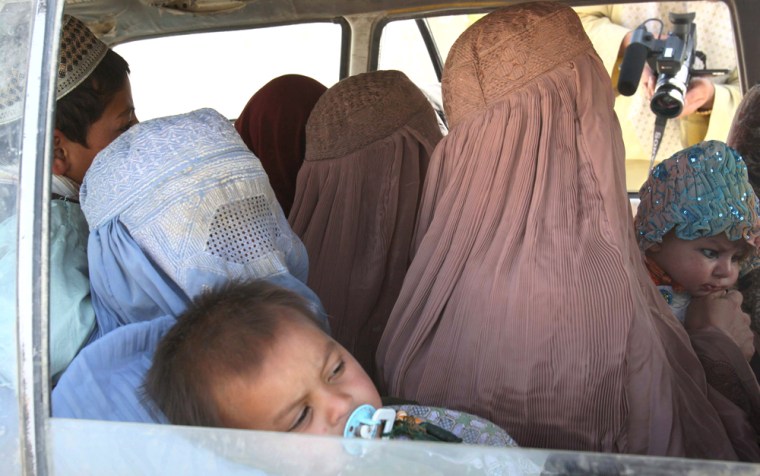Afghan civilians piled belongings onto trucks Wednesday and fled two villages infiltrated by hundreds of Taliban militants outside Afghanistan’s second-largest city. U.S., Canadian and Afghan troops had about 250 of the insurgents surrounded.
The troops killed 50 militants in three days of fighting 15 miles north of Kandahar city, the provincial police chief said. Three policemen and one Afghan soldier also died.
“The people are fleeing because the Taliban are taking over civilian homes,” Sayed Agha Saqib said. “There have been no airstrikes. We are trying our best to attack those areas where there are no civilians, only Taliban.”
250 surrounded
Saqib said 250 militants were surrounded, and 16 suspected Taliban have been arrested.
In eastern Afghanistan, meanwhile, a nighttime raid on a compound sparked a gunbattle late Wednesday that left three people dead, including two children, officials said Thursday.
The U.S. and Afghan troops clashed with suspected militants belonging to a suicide bombing network at a compound in Bati Kot district in Nangarhar province, said Maj. Chris Belcher, a spokesman for the U.S.-led coalition.
After the clash, a militant and two children were found dead inside the compound, Belcher said, and a woman and another child were wounded. The military has launched an investigation in the case, he said.
“It is regrettable that the civilian lives were put in danger by the militants and our sincere condolences goes to the families of the deceased and wounded,” Belcher said.
Afghan President Hamid Karzai has pleaded repeatedly with Western forces to do all they can to prevent civilian deaths, which have sparked resentment and demonstrations against U.S. forces.
Tribal leader death
Fighters moved into the Arghandab district of Kandahar province this week, about two weeks after the death of a tribal leader, Mullah Naqib, who had kept Taliban fighters out of his region. Karzai traveled to Kandahar for Naqib’s funeral.
“He was a good influence for his tribe. He was supporting the government,” Saqib said of Naqib. “After he died the Taliban were thinking they would go to Arghandab and cause trouble for Kandahar city. But now they’re surrounded and they’re in big trouble.”
The gathering of fighters on the doorstep of Kandahar — the Taliban’s former power base — is reminiscent of last year’s battle in neighboring Panjwayi district, one of the biggest fights in Afghanistan since the 2001 U.S.-led invasion.
NATO officials have said hundreds of Taliban tried to overrun Kandahar last year. But Saqib said he did not believe the militants occupying the villages of Chaharqulba and Sayedan would attempt a run on Afghanistan’s main southern city.
“We are capturing and killing them and I don’t think it will cause any problem for Kandahar,” he said.
Harvest season
U.S. Humvees and Canadian jeeps crossed Arghandab’s countryside on patrols Wednesday alongside hundreds of Afghans fleeing the area in the middle of harvest season, leaving their pomegranate crop at prime picking time.
Karimullah Khan piled his three children into the front seat of a pickup truck and put three female relatives in the back beside household goods and clothes. He was driving to Kandahar city to stay with relatives, he said.
“The Taliban came into our village and they told us to leave,” Khan said. “We just packed up our necessities and left. Our pomegranate orchard and home we left behind.”
Violence in Afghanistan this year is the deadliest since the invasion that toppled the Taliban regime. More than 5,600 people have died in insurgency-related violence, according to an Associated Press count based on figures from Afghan and Western officials.
Zarif Khan, the head of a fleeing family of 15, said he had no place to take his relatives, and may have to rent a room in Kandahar city. His family also left its pomegranate crop.
“Our livelihoods depend on this pomegranate crop, but these stupid Taliban came and started fighting,” he said. “We’ve got big trouble after losing our leader.”
The insecurity in the south has also fueled an explosion in Afghanistan’s opium crop, source of most of the world’s heroin. In Kabul, the U.N. anti-drug chief warned that a “tsunami” of opium will hit Afghanistan’s neighbors if border security remains weak and officials fail to intercept the drug, whose profits fund terrorism.
Afghanistan’s opium poppy harvest poses a “major threat” to neighboring countries because more than 90 percent of the profits flow to international criminal gangs and terrorists, said Antonio Maria Costa, chief of the U.N. Office on Drugs and Crime.
Afghanistan saw a record harvest of 9,000 tons of opium in 2007, the U.N. said, a 34 percent increase from 2006. The export value of the opium is estimated at $4 billion.
